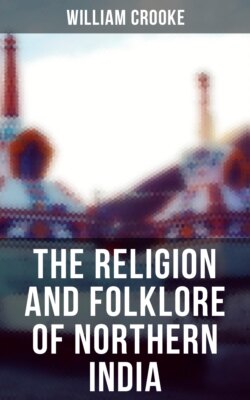Читать книгу The Religion and Folklore of Northern India - William Crooke - Страница 61
На сайте Литреса книга снята с продажи.
Worship of Bhîshma.
ОглавлениеTable of Contents
In about the same rank as Bhîmsen is Bhîshma, “the terrible one,” another hero of the Mahâbhârata. To the Hindu nowadays he is chiefly known by the tragic circumstances of his death. He was covered all over by the innumerable arrows discharged at him by Arjuna, and when he fell from his chariot he was upheld from the ground by the arrows and lay as on a couch of darts. This Sara-sayya or “arrow-bed” of Bhîshma is probably the origin of the Kantaka-sayya or “thorn-couch” of some modern Bairâgis, who lie and sleep on a couch studded with nails. He wished to marry the maiden Satyavatî, but he gave her up to his father Sântanu, and Bhîshma elected to live a single life, so that his sons might not claim the throne from his step-brethren. Hence, as he died childless and left no descendant to perform his funeral rites, he is worshipped with libations of water on the Bhîshma Ashtamî, or 23rd of the month of Mâgh; but this ceremony hardly extends beyond Bengal.
In Upper India five days in the month of Kârttik (November-December) are sacred to him. This is a woman’s festival. They send lamps to a Brâhman’s house, whose wife during these five days must sleep on the ground, on a spot covered with cow-dung, close to the lamps, which it is her duty to keep alight. The lamps are filled with sesamum oil, and red wicks wound round sticks of the sesamum plant rest in the lamp saucers. A walnut, an âonla (the fruit of the emblic myrobolon), a lotus-seed, and two copper coins are placed in each lamp. Each evening the women come and prostrate themselves before the lamps or walk round them. They bathe on each day of the feast before sunrise, and are allowed only one meal in the day, consisting of sugar-cane, sweet potatoes and other roots, with meal made of amarinth seed, millet and buckwheat cakes, to which the rich add sugar, dry ginger, and butter. They drink only milk. Of course the Brâhman gets a share of these good things, to which the rich contribute in addition a lamp-saucer made of silver, with a golden wick, clothes, and money. At the early morning bath of the last day five lighted lamps made of dough are placed, one at the entrance of the town or village, others at the four cross-roads, under the Pîpal or sacred fig tree, at a temple of Siva, and at a pond. This last is put in a small raft made of the leaves of the sugar-cane, and floated on the water. A little grain is placed beside each lamp. After the lamps handed over to the Brâhman have burnt away or gone out, the black from the wicks is rubbed on the eyes and fingers of the worshippers, and their toe-nails are anointed with the remainder of the oil. All the articles used in the worship are well-known scarers of demons, and there can be little doubt that the rite is intended to conciliate Bhîshma in his character of a guardian deity, and induce him to ward off evil spirits from the household of the worshipper.
There is a curious legend told to explain the motive of the rite. A childless Râja once threatened to kill all his queens unless one of them gave birth to a child. One of the Rânîs who had a cat, announced that she had been brought to bed of a girl, who was to be shut up for twelve years, a common incident in the folk-tales.20 This was all very well, but the supposed princess had to be married, and here lay the difficulty. Now this cat had been very attentive during this rite in honour of Bhîshma, keeping the wicks alight by raising them from time to time with her paws, and cleaning them on her body. So the grateful godling turned her into a beautiful girl, but her tail remained as before. However, the bridegroom’s friends admired her so much that they kept her secret at the wedding, and so saved the Rânî from destruction, and when the time came for the bride to go to her husband her tail dropped off too. So Hindu ladies use the oil and lamp-black of Bhîshma’s feast day as valuable aids to beauty. Such cases of animal transformation constantly appear in the folk-tales. In one of the Kashmîr stories a cat, by the advice of Pârvatî, rubs herself with oil and is turned into a girl; but she does not rub a small patch between her shoulders, and this remained covered with the cat’s fur.21
The worship of the heroes of the Mahâbhârata does not prevail widely, unless we have a survival of it in the worship of the Pânch Pîr. At the last Census in the North-Western Provinces less than four thousand persons declared themselves worshippers of the Pândavas. The number in the Panjâb is even smaller.
